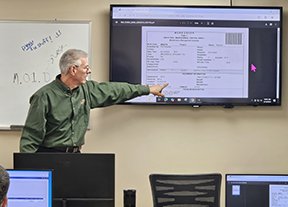Published: February 28, 2023 | Updated: November 19, 2025
Published: February 28, 2023 | Updated: November 19, 2025
Achieving Success with Your CMMS: A Detailed Guide
As Eternal Grandmaster H. U. Lee said, "Today Not Possible, Tomorrow Possible." This highlights the journey from aspiration to achievement. This sentiment perfectly captures the potential for achieving success with your Computerized Maintenance Management System (CMMS). The initial discussion in this series outlined foundational points for CMMS success. This installment builds upon that, detailing critical phases from planning to ongoing improvement, all vital for transforming maintenance operations.
Strategic Planning for Your CMMS Journey
 Before any significant investment, thoughtful planning establishes a clear path. If a CMMS is not yet in place, a thorough review of expectations for the system is essential. What specific areas of maintenance, inventory, or purchasing require improvement? Having succinct discussion points, much like crafting a concise proposal, helps a salesperson focus on the most beneficial system features. Consider the reasonable goals set in the previous discussion and the wisdom of taking things one step at a time.
Before any significant investment, thoughtful planning establishes a clear path. If a CMMS is not yet in place, a thorough review of expectations for the system is essential. What specific areas of maintenance, inventory, or purchasing require improvement? Having succinct discussion points, much like crafting a concise proposal, helps a salesperson focus on the most beneficial system features. Consider the reasonable goals set in the previous discussion and the wisdom of taking things one step at a time.
While a CMMS offers comprehensive organizational capabilities for assets, inventory, work orders, and purchasing, starting with one maintenance segment often proves more beneficial. Witnessing results in a smaller scope builds confidence before expanding CMMS usage. This phased approach prevents overwhelming supervisors, administrators, or other team members, ensuring a smoother transition and greater buy-in.
Seamless Implementation and Initial Use
Once the decision and investment are complete, familiarization with the system begins. Start by inputting essential user information, a core list of assets, and key inventory items. After this basic information is in place, add a few preventive maintenance jobs. This initial data entry, much like outlining a story before writing, provides structure for the CMMS.
Engaging with the CMMS support team for assistance during this phase proves invaluable. They often provide data entry tips or tricks that speed up the process or make it more efficient. The key here is to get started, providing an initial feel for how the system operates in a real-world context.
Comprehensive Training for Proficiency

Training represents a vital learning point, mirroring the dedication required to master any new skill. For a CMMS, consider the initial learning experience. An administrator and a few key system users benefit significantly from attending dedicated training sessions. Three primary methods exist for this crucial learning phase: in-house, on-site, and online.
In-house training offers a structured yet informal classroom setting. This environment allows ample time for questions and discussions. A significant benefit includes meeting representatives from other companies, fostering networking, and sharing stories on how the system is applied in diverse settings. This broadens understanding and offers new perspectives on CMMS utility.
On-site training provides an immediate, practical learning experience. It resembles on-the-job training, where users apply the system directly to ongoing operations. A major advantage of this method is the trainer's ability to tailor sessions to specific needs and observe operations firsthand, providing highly relevant guidance.
Online training presents a cost-effective method, especially for reducing travel expenses. These sessions typically last an hour or two, requiring less time commitment than full-day training, allowing for flexibility in scheduling. Each training method carries distinct advantages, offering options to suit various operational demands and learning preferences.
Discover how streamlined maintenance processes can elevate production. Learn more.
Integrating the CMMS into Daily Operations
Just as a writer commits to putting words on paper, a specific time arrives to incorporate the CMMS into daily business activities. As time progresses and positive results appear, consider expanding the use of features and options, extending the system's application to other areas of maintenance. A key consideration, often mentioned in training, involves consistency, particularly in naming and describing assets and inventory.
This consistency, much like using a consistent style guide in writing, eases search times for particular items. For example, if several belts are in stock but named inconsistently, searching for a specific belt becomes challenging. However, if the keyword "Belt" begins each entry, or the description starts with "belt," searching becomes significantly easier by sorting alphabetically. This attention to detail in data entry pays dividends in efficiency.
Leveraging Mobile CMMS Applications
Consider equipping workers in the field with CMMS access on mobile devices. This eliminates the need to return to the office to complete work orders, call for inventory quantities, or submit work requests. Mobile access streamlines workflows, providing real-time data input and access, directly impacting productivity and responsiveness.
Customization for Unique Business Needs
Should a company require a special report or feature, the CMMS vendor should collaborate to make it happen. The system must possess sufficient flexibility to allow for special additions. This adaptability ensures the CMMS aligns perfectly with unique operational demands.
Ongoing Support and Continuous Improvement
Support remains a critical element on the journey to CMMS success. Questions will arise, and the CMMS company's support team plays a crucial role. A positive attitude and a genuine desire to assist are essential. The support team needs to know how to ask the right questions to diagnose issues quickly and understand when to involve others for assistance, even using remote access to see problems firsthand. This level of support significantly contributes to CMMS success and demonstrates the system's value and the company behind it.
Utilizing CMMS Reports for Evaluation
CMMS-generated reports provide vital insights, recalling the importance of clear evaluation. These reports should offer enough filters to narrow information to precisely what is needed. Evaluating the results of CMMS usage through cost and key performance indicator (KPI) reports reveals areas for improvement and confirms successful strategies.
Embracing System Updates for Growth
Once initial success is achieved, the focus shifts to the next goal. A CMMS should evolve and improve as the business does. Regular updates ensure the system remains current, incorporating new features and maintaining compatibility with changing technological landscapes.
The role of communication and discipline is apparent with a CMMS. Because the CMMS excels as an organizer, internal communication greatly improves. Clear work orders and accurate tracking of equipment and asset readings enhance information flow. Moreover, consider asking the CMMS company to integrate the system with accounting, enterprise resource planning, or other third-party systems. This integration fosters better communication with other departments, creating a more cohesive operational environment.
Achieving success with a CMMS presents a challenging yet achievable goal. It involves venturing into new operational territory, yet the potential for significant gains is clear. With dedication and the backing of a supportive CMMS provider, this success is well within reach, fundamentally transforming maintenance operations.
FAQs
What are the key steps to successful CMMS implementation?
Success with CMMS begins with careful planning, phased implementation, proper training, and ongoing support.
Why is training important when using a CMMS?
Training ensures users understand features, adopt best practices, and maximize the system’s capabilities.
How does mobile CMMS access improve maintenance operations?
Mobile CMMS apps let technicians update work orders, track inventory, and access data in real time, improving efficiency.
Can a CMMS like MAPCON be customized for specific business needs?
Yes, MAPCON CMMS allows custom reports and features, ensuring the system adapts to unique operational demands.
How do CMMS reports help maintenance teams?
Reports track costs, KPIs, and performance data, providing insights for continuous improvement.
Why is vendor support critical for CMMS success?
Strong vendor support helps resolve issues quickly, ensures smooth adoption, and maximizes long-term system value.
MAPCON | 800-922-4336
MAPCON CMMS software empowers you to plan and execute PM tasks flawlessly, thanks to its wealth of features and customizable options. Want to see it for yourself? Click the button below to get your FREE 30-day trial of MAPCON!
Try It FREE!